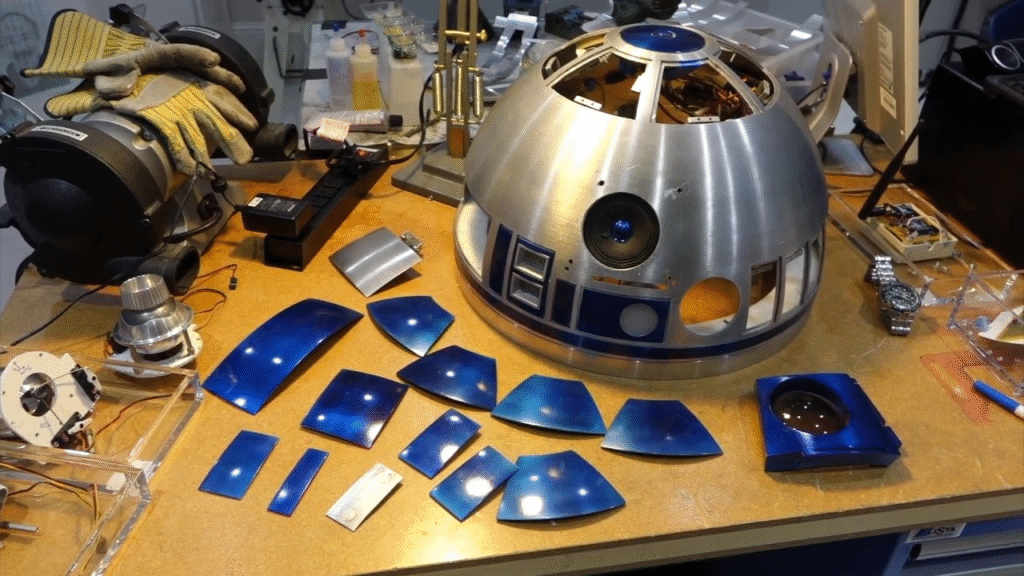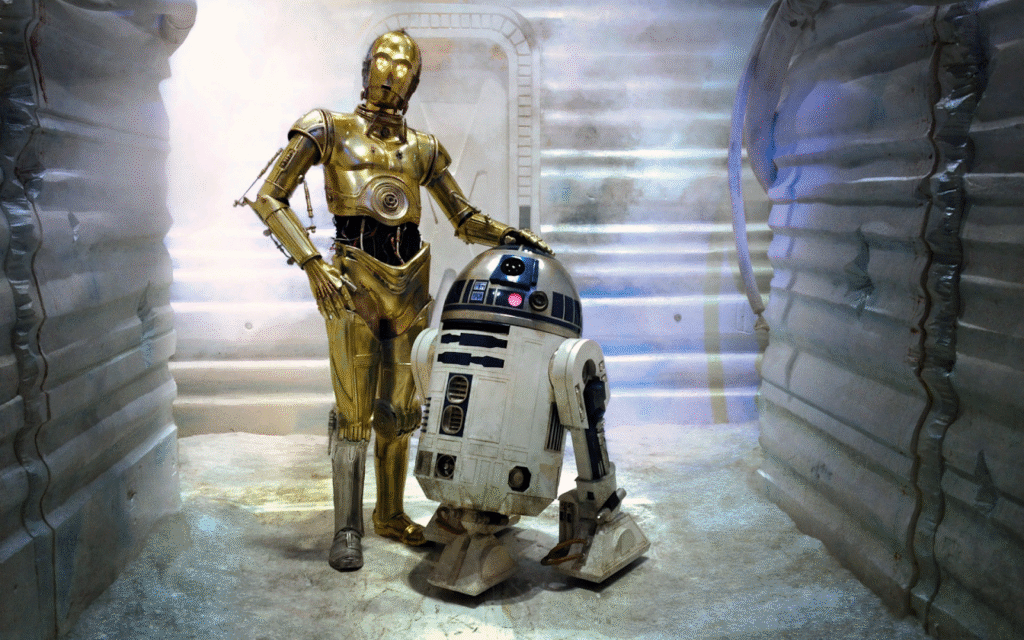
The Galactic Assignment of a Lifetime
For most automation technicians, the job involves factory floors, assembly lines, and robotic arms that weld or sort packages. But imagine being assigned to one of the most famous droids in cinematic history R2-D2, the astromech hero of the Star Wars universe. For six months, you’re not just maintaining a machine; you’re ensuring the survival of an entire starship crew across galaxies.
This is what it would be like to live and work as a certified automation technician aboard a galactic starship keeping R2-D2, C-3PO, and other robotic systems running after hyperspace jumps, asteroid collisions, and the occasional Imperial blaster fire.
Life Aboard the Starship: Beyond the Stars and into the Circuits
Your assignment begins aboard the CR90 Corellian Corvette, a starship built for speed and durability. This ship, often used by the Rebel Alliance, has a streamlined design that combines both human and droid functionality.
Basic Schematic Overview of the Starship
- Bridge Command Center – The nerve center where pilots and navigators work side-by-side with astromech droids like R2-D2 to manage hyperspace routes.
- Engineering Bay – The technician’s home. Here, diagnostics consoles, plasma welders, and tool racks line the walls. This is where you’ll spend most of your time keeping mechanical systems operational.
- Droid Maintenance Bay – A specialized section filled with recharging docks, data ports, and diagnostic arms. It’s the mechanical equivalent of a hospital for droids.
- Living Quarters – Compact sleeping pods for technicians and officers. Expect gravity fluctuations and constant mechanical hums from the hyperdrive core.
- Cargo and Repair Deck – A vast, dimly lit area where you can often find R2-D2 tinkering with his own modifications or rescuing half-burnt circuitry after another mission gone wrong.
Living aboard a starship isn’t glamorous. You’re always working against cosmic dust infiltration, mechanical wear, and the relentless curiosity of R2-D2, who tends to “upgrade” himself when you’re not looking.
Working with R2-D2: The Galaxy’s Most Independent Colleague

R2-D2 is more than a machine; he’s a personality. As a certified automation technician, your first task is to understand that he doesn’t always follow the manual. He has a knack for improvisation, especially under pressure.
During your first week, you might notice strange readings from his motivator circuits. By week two, he’s re-routing his own power to boost communications range. By week three, he’s hacked into the ship’s navigation logs to plot safer routes completely autonomously.
Your challenge? Keeping up.
Daily Tasks Include:
- Running diagnostic scans on his logic circuits to prevent data corruption.
- Recalibrating servo motors and rotational joints damaged during high-speed maneuvering.
- Cleaning carbon scoring from his outer shell after blaster skirmishes.
- Monitoring power cell efficiency, which depletes faster in hyperspace environments.
- Synchronizing his memory core with the ship’s mainframe for shared navigation data.
And don’t forget his counterpart, C-3PO, the protocol droid fluent in over six million forms of communication. His complaints about maintenance procedures are legendary. As he’d say, “It’s highly irregular to dismantle a functioning droid!”
Maintenance After the Missions: Battle Damage and Droid Repairs
When the ship returns from a mission, your real work begins. The droids often bear the marks of their heroic scorched plating, melted circuits, and sometimes, entire limbs missing.
Common Repairs You’ll Perform:
- Motivator Replacement: The motivator controls R2-D2’s mobility and communication circuits. After any high-stress battle, this component often needs realignment or full replacement.
- Memory Core Cleaning: Space dust and data fragmentation can cause lag in his responses. You’ll spend hours debugging corrupted data from hyperspace travel.
- Welding & Repainting: You’ll patch hull damage and restore that iconic blue-and-white shine.
- Servo Synchronization: After impact or shock events, his servos can drift out of alignment, affecting mobility.
- Hydraulic Pressure Rebalancing: For C-3PO, the delicate balance in his articulation hydraulics must be recalibrated frequently, especially after panic-induced motion sequences.
These repairs are not just technical, they’re emotional. You’ll find yourself talking to R2-D2 like a colleague, sharing laughs through his chirps and beeps. His occasional head swivel feels like acknowledgement.
The Challenges of the Job: More Than Meets the Eye
Being a certified automation technician on a starship means adapting to environments no Earth-based manual could prepare you for.
- Temperature Extremes: Engine rooms fluctuate between freezing cold and molten heat due to plasma conduits.
- Zero Gravity Repairs: Fixing an astromech’s circuit board while floating upside-down is a rite of passage.
- AI Personality Conflicts: C-3PO’s sensitivity can cause verbal sparring during maintenance, while R2-D2’s stubborn independence might trigger unexpected “self-repair” attempts.
- Hard-to-Find Parts: Out in deep space, sourcing specific actuator gears or quantum logic chips becomes a scavenger hunt across systems.
It’s no wonder that experienced industrial automation technicians are hard to find, especially those comfortable working alongside sentient machines with personalities.
Life Lessons from the Galaxy’s Smartest Droids
Over six months, you learn patience, adaptability, and a deep appreciation for machine intelligence. R2-D2’s resilience teaches you that function doesn’t need formality. He can bypass half his circuits and still save the day.
C-3PO, despite his anxiety, reminds you that communication is key both between humans and machines. Together, they represent the ideal partnership between human creativity and robotic precision.
The ship itself feels alive, the hum of engines syncing with R2’s electronic tones, the flickering lights in the corridor signaling the ship’s moods, and the quiet companionship of your mechanical crewmates reminding you that “life” takes many forms.
The Final Week: Preparing for the Next Technician
As your assignment nears its end, you begin creating maintenance logs and procedural notes for the next certified automation technician. Your final entry reads:
“R2-D2 prefers working with minimal interference but responds well to cooperative problem-solving. Never underestimate his ability to self-diagnose. C-3PO requires reassurance more than repairs. Both are invaluable to the mission.”
Before you depart, R2-D2 emits a cheerful sequence of beeps. C-3PO translates, “He says he’ll miss your efficient service, though your wrench handling could use refinement.”
It’s a fitting farewell from two of the galaxy’s most iconic machines.
Conclusion: The Galaxy Awaits the Next Engineer
As the ship jumps into hyperspace, your six months feel like six light-years of growth. You’ve seen technology and life blend in ways no Earth-bound factory could offer.
Working as a certified automation technician aboard a galactic starship is not just a job, it’s a journey through innovation, camaraderie, and the infinite frontier of artificial intelligence.
And as the next maintenance rotation begins, the ship’s announcement echoes through the corridors:
“Now hiring: Certified Automation Technician. Must be willing to work with independent-minded droids.”
Somewhere in the galaxy, R2-D2 emits a happy chirp ready to test the patience of his next human partner.

